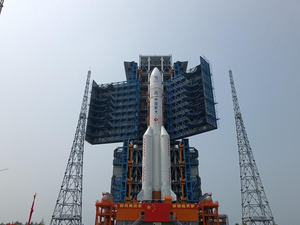Beijing: China is set to launch its Chang’e-6 lunar probe to the Moon’s mysterious far side to Earth — the first endeavour of its kind in the history of human lunar exploration, the China National Space Administration (CNSA) said Friday.
According to the CNSA, the Chang’e-6 lunar probe is scheduled to be launched between 5 p.m. and 6 p.m. (Beijing Time) (2.30 p.m. to 3.30 p.m. IST) Friday, Xinhua news agency reported.
The Chang’e-6 mission aims to collect and return samples from the Moon’s mysterious far side to Earth.
The Long March-5 Y8 rocket, which will carry the Chang’e-6 probe, has begun the process of taking on liquid oxygen cryogenic propellant at the Wenchang Space Launch Site on the coast of China’s southern island province of Hainan, the CNSA added. This propellant will serve as fuel for the carrier rocket.
The Chang’e-6 spacecraft comprises an orbiter, a lander, an ascender and a returner.
The mission will carry four payloads developed through international cooperation. Scientific instruments from France, Italy, and the European Space Agency are aboard the Chang’e-6 lander, while a small satellite from Pakistan is aboard the orbiter.
About 50 guests from 12 countries and international organisations have been invited by the CNSA to attend a workshop focusing on the international payloads carried by Chang’e-6 and witness the launch in Hainan.
An impact crater known as the Apollo Basin, located within the South Pole-Aitken Basin on the far side of the Moon, has been chosen as the primary target landing and sampling site for the Chang’e-6 mission.
After the spacecraft reaches the Moon, it will make a soft landing. Within 48 hours after landing, a robotic arm will be extended to scoop rocks and soil from the lunar surface, while a drill will be used to bore into the ground. Scientific detection work will be carried out simultaneously.
After the samples are sealed in a container, the ascender will take off from the Moon and dock with the orbiter in lunar orbit. The returner will then carry back the samples to Earth, landing in Siziwang Banner in north China’s Inner Mongolia Autonomous Region. The entire mission is expected to last about 53 days, the CNSA said.






